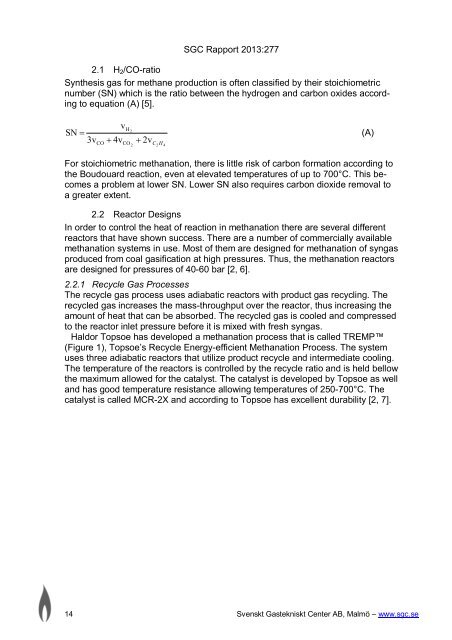Carbon dioxide removal in indirect gasification - SGC
Carbon dioxide removal in indirect gasification - SGC
Carbon dioxide removal in indirect gasification - SGC
You also want an ePaper? Increase the reach of your titles
YUMPU automatically turns print PDFs into web optimized ePapers that Google loves.
<strong>SGC</strong> Rapport 2013:277<br />
2.1 H2/CO-ratio<br />
Synthesis gas for methane production is often classified by their stoichiometric<br />
number (SN) which is the ratio between the hydrogen and carbon oxides accord<strong>in</strong>g<br />
to equation (A) [5].<br />
SN<br />
H 2<br />
(A)<br />
3v<br />
CO<br />
v<br />
4v<br />
CO<br />
2<br />
2v<br />
C H<br />
2<br />
4<br />
For stoichiometric methanation, there is little risk of carbon formation accord<strong>in</strong>g to<br />
the Boudouard reaction, even at elevated temperatures of up to 700°C. This becomes<br />
a problem at lower SN. Lower SN also requires carbon <strong>dioxide</strong> <strong>removal</strong> to<br />
a greater extent.<br />
2.2 Reactor Designs<br />
In order to control the heat of reaction <strong>in</strong> methanation there are several different<br />
reactors that have shown success. There are a number of commercially available<br />
methanation systems <strong>in</strong> use. Most of them are designed for methanation of syngas<br />
produced from coal <strong>gasification</strong> at high pressures. Thus, the methanation reactors<br />
are designed for pressures of 40-60 bar [2, 6].<br />
2.2.1 Recycle Gas Processes<br />
The recycle gas process uses adiabatic reactors with product gas recycl<strong>in</strong>g. The<br />
recycled gas <strong>in</strong>creases the mass-throughput over the reactor, thus <strong>in</strong>creas<strong>in</strong>g the<br />
amount of heat that can be absorbed. The recycled gas is cooled and compressed<br />
to the reactor <strong>in</strong>let pressure before it is mixed with fresh syngas.<br />
Haldor Topsoe has developed a methanation process that is called TREMP<br />
(Figure 1), Topsoe’s Recycle Energy-efficient Methanation Process. The system<br />
uses three adiabatic reactors that utilize product recycle and <strong>in</strong>termediate cool<strong>in</strong>g.<br />
The temperature of the reactors is controlled by the recycle ratio and is held bellow<br />
the maximum allowed for the catalyst. The catalyst is developed by Topsoe as well<br />
and has good temperature resistance allow<strong>in</strong>g temperatures of 250-700°C. The<br />
catalyst is called MCR-2X and accord<strong>in</strong>g to Topsoe has excellent durability [2, 7].<br />
14 Svenskt Gastekniskt Center AB, Malmö – www.sgc.se

















